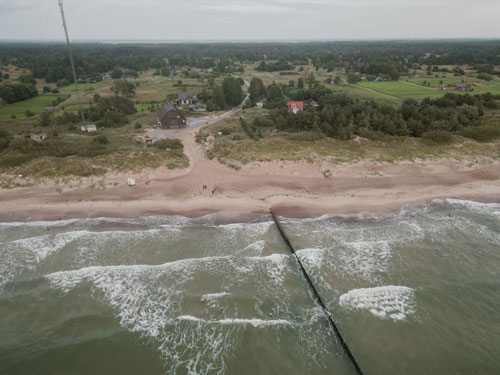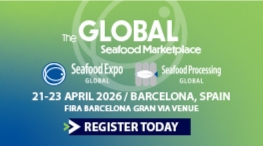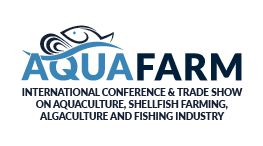This article was featured in Eurofish Magazine 5 2025.
Teenagers from Latvia and Germany visited a traditional fishing centre to learn how to preserve coastal fisheries customs while using new technologies to adapt them to the modern day.
In July this year, Jūrmalciems on Latvia’s Baltic coast hosted an international youth summer camp, bringing together teenagers from Latvia and Germany to explore the past, present, and future of fisheries. Dedicated to coastal and inland fishing and supported by the Latvian Fish Fund, the camp marked its tenth edition in the past nine years. In total, 30 young people aged 14 to 18 took part – 22 from Latvia and 8 from Germany.
From Soviet traditions to 21st-century challenges
Jūrmalciems is one of Latvia’s traditional fishing centres, where coastal fishing practices established during Soviet times have been preserved. Youth camps were already organised here in the 1990s and early 2000s, and in recent years they have taken place along the Baltic Sea and Gulf of Riga coastlines, involving young people from Latvia, Lithuania, and Germany.
The camp aimed to raise awareness among young people and teachers about the historic fishing traditions of Jūrmalciems, while also presenting modern solutions and showcasing how local customs can be enriched with new technologies. Participants explored the history of fishing, current challenges in the sector, and opportunities for future development. They also learned about the latest research on Baltic Sea fish stocks. A central ambition was to inspire them to imagine new business opportunities linked to fisheries.
Tourism and innovation as lifelines for coastal communities
The number of coastal fishers in Latvia has plummeted from 250 in 2004 to just 140 in 2025, according to the Ministry of Agriculture. With the average age of fishers rising, it is becoming increasingly difficult to introduce new technologies and modernise the sector. One solution is to combine fisheries with other industries, such as tourism. This not only helps preserve the identity and heritage of coastal communities, both tangible and intangible, but also creates new economic opportunities.
Jūrmalciems is more than just a modern fishing centre, its history is closely tied to the development of Latvian coastal fisheries. In 1937, the community landed 561 tonnes of cod, making it the second most productive fishing site in Latvia after Liepāja. That same year, President Kārlis Ulmanis visited Jūrmalciems, showing deep interest in the lives and needs of the fishers. He praised their achievements and suggested using seaweed as fertiliser to ensure good harvests in sandy coastal soils. The visit reinforced the idea that in Jūrmalciems the coastal way of life could thrive with national support.

Located on the Latvian coast, Jūrmalciems, the site of the youth camp,
has a long history of youth camps and an even longer one of fisheries.
Today, Jūrmalciems’ fishing traditions blend with innovation. Local fishers such as Oskars Kadeģis, Jānis and Dzintars Ziemelis, and Ivars Roga are working to preserve their heritage while adopting modern technologies and comforts. Knowledge gained abroad has helped them create a more attractive environment for younger colleagues. The Latvian Fishermen’s Federation works closely with teachers from the Oskars Kalpaks Secondary School in Liepāja and certified camp leaders to ensure that the younger generation is educated on Baltic Sea fisheries and ecological issues. For coastal fishers, compared to large trawler owners, it is especially important to preserve traditional knowledge and pass it on. This includes exploring e-technologies, short supply chains, logistics solutions, and in the future, the use of artificial intelligence.
Hands-on learning from experts and fishers
The camp featured experts from the Ministry of Agriculture’s Fisheries Department, BIOR, the Nature Conservation Agency, the State Environmental Service, the University of Latvia, Riga Stradiņš University, Riga Technical University, the Latvian Fishermen’s Federation, and the Latvian Environment, Geology and Meteorology Centre, as well as certified nature guides and coastal fishers. Guest speakers included well-known Latvian TV host and angling champion Normunds Grabovskis, biologist and journalist Māris Olte, and representatives of the Latvian Rural Advisory and Training Centre.
The programme included lectures on the competitiveness of Latvian fisheries and Baltic Sea fish stock research; exploration of the ecosystem-based approaches to fisheries; practical work such as seine hauling and fish fry counts; discussions on defending the rights of coastal communities; masterclasses in fish smoking and making fishing gear; as well as excursions to learn from coastal community development.
Stories, skills and films – the youth shares their vision
Participants were tasked with creating a video and an educational session about the fishers of Jūrmalciems and their efforts to preserve and develop their traditional way of life. These were presented to teachers and pupils in Liepāja and Paderborn (Germany) and published on Facebook and the regional media outlet liepajniekiem.lv. The organisers hope the camp will inspire similar initiatives across Europe, encouraging cooperation, knowledge exchange, and greater engagement of young people in the fisheries sector.
Ēvalds Urtāns,
Latvian Fishermen’s Federation









